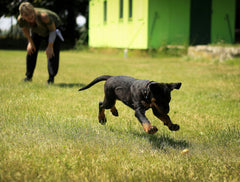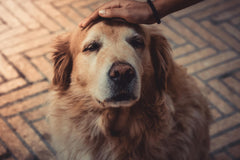
Cinematic physique but not a love face...
Here is a dog with a look: tall, slender, short coat, a beautiful black and tan color, a body with protruding muscles, a chiseled head and a look of embers. A dog with a mouth, but not only a mouth, we will see it. A remarkable physique, a cinematic physique. The physique of a seducer? Jack Palance, Lino Ventura, Charles Bronson had the physique of a movie star, no doubt, but not the physique of a young man. They have the physique of villains, or at least tough guys, even if they knew how to be tender... Same for the Dobermans. You can see them in Rambo (First Blood), where they couldn't be good company any more than the other characters; in Is There Someone to Kill My Wife, Sam's Doberman named Adolf is destined to kill Muffy; in the Magnum series, the guardians of the property are the Dobermans Appolon and Lens; in Those Boys from Brazil, remember who shreds Dr. Mengele? Dobermamns. Flayed Dobermans... Exactly, to make them appear like that, they had to be prepared, they had to be made up in some kind of make-up. Look at the bonuses: how cute and docile these dobies are... They're manipulated, covered with bloody strips, just before shooting the scenes where they're going to show their teeth...
It is clear that by appearing in these roles, the Doberman Shepherds did not make as many groupies as the German shepherd who owes so much to Rin-tin-tin, the Pyrenean mountain dog revived by Belle and Sebastian or the Dalmatian who, if the cartoon had not made him known, would have disappeared.
Well, at least the Doberman is a well-known dog. But also, it was to be expected, unknown, and therefore unloved by many.
It was invented by someone you wouldn't imagine nice because he was a tax collector: a certain Karl Friedrich Ludwig Doberman. History tells that he wanted to protect himself from highwaymen and recalcitrant taxpayers. Above all, he was also in charge of the impoundment of the town of Apolda, near Weimar, and thus had a reservoir of breeding stock and kennels that made breeding easier. We are on the eve of the birth of the German Empire and canine breeding is taking its first steps in Europe. Friedrich Doberman creates a breed from what is brought to the pound. This is easier than having to roam the countryside on horseback in search of more or less well-known stallions. It took a lot of motivation to create a breed in the 19th century... And what breed... Everyone can have his own idea about the breed.
The origins, the contributions of the various blood streams, the crossbreeding, the result is there: the Doberman is a very beautiful breed and a very good breed to use.
Printing, expression
The Doberman has always been very beautiful. There are few pictures of these dogs with a sweltering back, fine bones and bad legs. Of course the breed has evolved since its creation, but it is not today that most of the subjects are real athletes.
The modern Doberman is a dog whose proportions are almost always excellent. They are long without being light or slender, with strong bones and muscles that are clearly visible under a loose skin and shiny coat. With that, a beautiful well chiselled head, well parallel skull-breast lines and a cold, calculating look. Is the expression inappropriate? Well, too bad. She from me. That's the impression I get from her expression. As for the rest, let's refer to the switchboard.
The standard, of course, talks about character.
Friendly and peaceful dog. That's right: the current Doberman conforms well to the standard, even if, as we have just seen, the media have given the image of a ferocious dog.
We are looking for a temperament and a bite of medium intensity (...): the Doberman does not have the biting qualities of the Malinois, and nobody disagrees. Some subjects are nevertheless "cracks in the web" as we say in the ring jargon;
Easy to train(...) the Doberman must be efficient, courageous(...): the Doberman is, according to the standard, a working dog. This is what its creators wanted. Those who only want to see him as a show or show dog are mistaken, even if this dog is peaceful in family and very affectionate. He is a serious dog. Not a living stuffed animal. Not him.
The Doberman has been used since its appearance as a guard and defense dog, since it was invented for that purpose. It was also used during the Great War. Some say that it was used as an assault dog in the trenches. It is a supposition: I have not found any trace of this use. Attack dogs would undoubtedly have been effective in spreading panic in the enemy trenches, but they would never have returned alive. Soldiers on both sides were careful not to endanger the dogs' lives. It is hardly believable, but it is true: the dogs of war were liaison dogs, sentinel dogs, sanitary dogs, but not fighting or intervention dogs, which moreover caused problems for the staffs. In All Quiet on the Western Front, Eric-Maria Remarque has a soldier pitying the suffering of a dying horse say that war is made for men and not for animals...
The Americans who imported Dobermans in the early 20th century also used them in their armies, even more so than the Germans. During the Battle of Guam in the Mariana Islands in 1944, 25 of these devil dogs, as the Marines called them, were killed while trying to flush out the Japanese enemy. In their honor, a memorial has been erected on the island of Guam.
The Doberman is still a working dog, but competition from the Malinois, and to a lesser extent the German Shepherd and the Rottweiler, leaves him little room for police, armies, security companies or sports. He is however the most impressive and his dissuasive aspect is for the users who patrol a major quality. Now, it is true that with its drooping Doberman floppy ears, the Doberman imposes less... So we won't see many more of them in Europe in train stations, airports, or at the end of the leash of policemen or soldiers. In the United States, where the Malinois is also THE dog to use, some administrations or security companies remain nevertheless faithful to the dobie. With the cut ears, that is to say with his expression. It is his expression that makes an impression. But make no mistake: the Doberman is not only impressive; when he has the aptitudes and is conditioned to bite, his power and determination make him the most formidable of the working dogs.
He's also a sports dog. Many Dobermans compete at the highest level in the ring and in RCI. The beauty champion F'Hiram Royal Bell, imported from Croatia by Jean-Paul Godart, did not have the great career as a working dog that could be expected of him. Jean-Paul explains: "I am not a workaholic. F'Hiram got his ring certificate and the RCI 1, and I stayed at that level." It was enough to get this good and beautiful dog noticed: F'Hiram has made more than 120 mating runs, and he reproduced well. His offspring are today numerous in the show rings and in the working rings.
So this is the revival of dob after the tumble brought on by the ban on ear sizes? Not so sure. For if it is true that breed lovers can find good working dogs in the herd, neither ring or RCI enthusiasts nor defense dog professionals will go looking for a Doberman with floppy ears. Even if, as Jean-Paul Godart, the new president of the club, explains, "harmony has been preserved thanks to a judicious selection on the heads...".
No one can disagree: the ban on otectomy is a bad blow to the breed, and neither will she ever fully recover from it. Doberman uncropped ears just don't look the same. This is a pity, because the breed has not suffered like so many others from interminable quarrels of people and the synchronic selection on morphology and character has advanced both, this which is not common in canine circles. Until this unacceptable ban, the breed's promoters could be considered to have had a bit of luck.
If the authorities knew how many dogs it takes to be successful in canine sport... And also how much perseverance.
Written by my friend, Jean-Yves Reguer.




